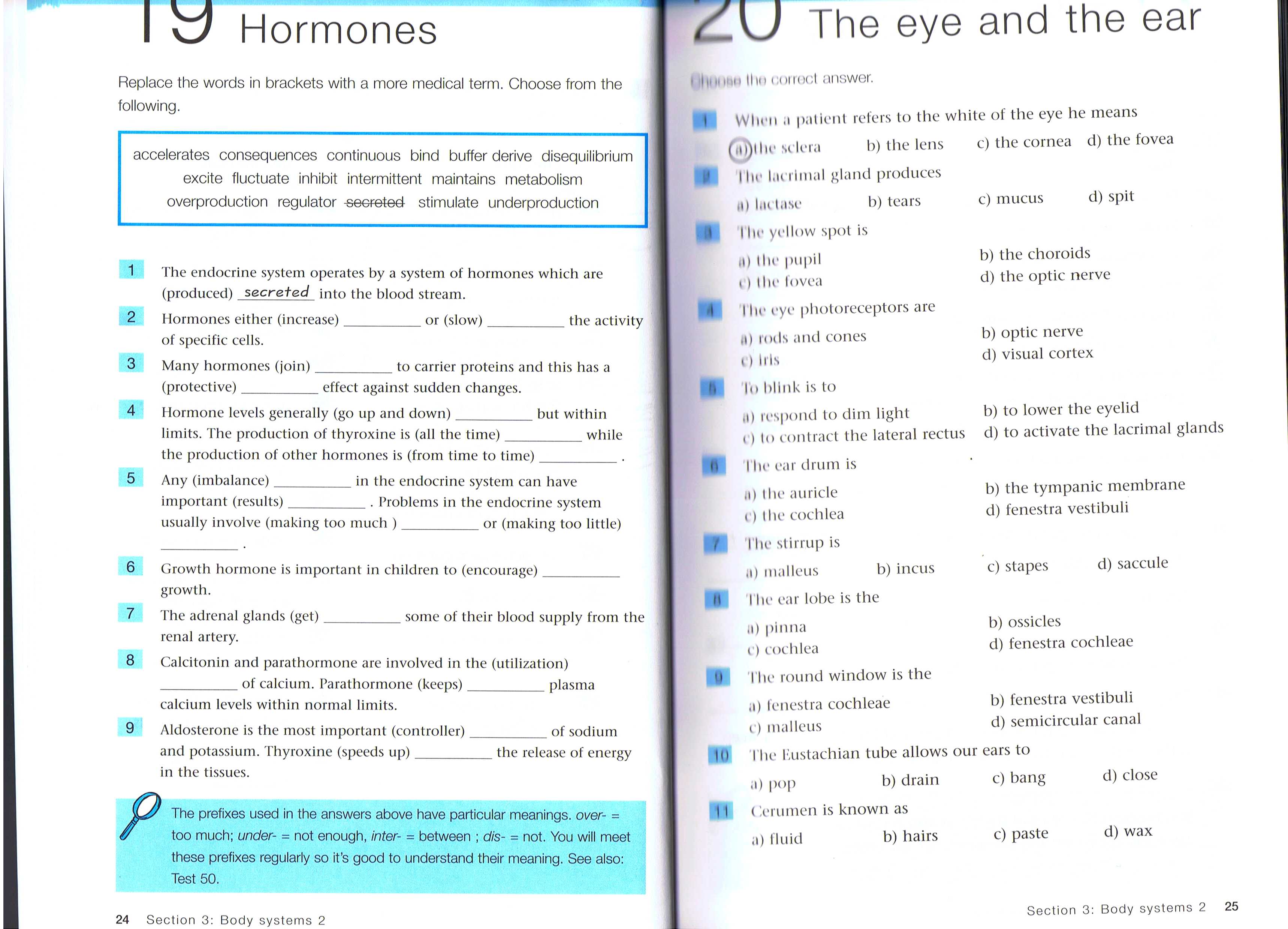24,25

I Hormones
Replace the words in brackets with a morę medical term. Choose from the following.
accelerates consequences continuous bind buffer derive disequilibrium excite fluctuate inhibit intermittent maintains metabolism overproduction regulator -seereted stimulate underproduction 1 2 3 4 5 6 7 8 9
The eye and the ear
wi Hm correct answer.
W lici i a palient refers to the white of the eye he means

®!l.c selera h) the lens
I he lacrimal gland produces
a) liulasc b) tears
I he yellow spot is
ii) Hic pupil i) Ilu1 fovea
I lic eye photoreceptors are
a) rods and cones c) Iris
lo 1)11nk is to
a) respond to dim iight r) lo contract the lateral rectus
The ear drum is
li) Ihc auricle
i) the cochlea
I hc stirrup is
u) malleus b) incus
The ear lobe is the
ii) plnna e) cochlea
The round window is the
ii) fenestra cochleae c) malleus
The Kustachian tubę allows our
ii) pop b) drain
(:erumen is known as a) fluid b) hairs
c) the cornea d) the fovea
c) mucus d) spit
b) the choroids
d) the optic nerve
b) optic nerve d) visual cortex
b) to lower the eyelid
d) to activate the lacrimal glands
b) the tympanic membranę d) fenestra vestibuli
c) stapes d) saccule
b) ossicles
d) fenestra cochleae
b) fenestra vestibuli d) semicircular canal
ears to
c) bang d) close
c) pastę d) wax
Section 3: Body Systems 2 25
The endocrine system operates by a system of hormones which are (produced) secrefzd into the blood stream.
Hormones either (increase)_or (slow)____ the activity
of specific cells.
Many hormones (join)_to carrier proteins and this has a
(protective)_effect against sudden changes.
Hormone levels generally (go up and down)_but within
limits. The production of thyroxine is (all the time)_while
the production of other hormones is (from time to time)_.
Any (imbalance)_in the endocrine system can have
important (results)_. Problems in the endocrine system
usually involve (making too much )_or (making too little)
Growth hormone is important in children to (encourage)_
growth.
The adrenal glands (get)_some of their blood supply from the
renal artery.
Calcitonin and parathormone are involved in the (utilization)
_of calcium. Parathormone (keeps)_plasma
calcium levels within normal limits.
Aldosterone is the most important (controller)_of sodium
and potassium. Thyroxine (speeds up)_the release of energy
in the tissues.
The prefixes used in the answers above have particular meanings. over- = too much; under- = not enough, inter- = between ; dis- = not. You will meet these prefixes regularly so it's good to understand their meaning. See also: Test 50.
24 Section 3: Body systems 2
Wyszukiwarka
Podobne podstrony:
Blockbouster 2 NPP TESTY I KLUCZE�22 Test 3 A Graramar C. Write the past simple form of the words in
Blockbouster 2 NPP TESTY I KLUCZE�26 Test 3 B Write the past simple «f the words in brackets. ......
249 (17) 24 : Diagnostic approach to feline pododermatoses Figurę 24:26: Multiple bacterial paronych
0106908575c071ff4508349b7e8b07e7 Lewiston Area Riverview Inn Dinę by the riverside in a truły cozy s
1-/?o In connection with morę and fcors often repeating beatial lneldente, volvca by German pciice i
af (6) CHAPTER 2Necklaces What better way to set off an outfit than with a beautiful crochet necklac
skanuj0054(1) ^ Complete the texts with the correct forms of the verbs in brackets. Use the present
File0050 1 Complete the sentences with the words in the box. ages dothes money shopping shops 5 błil
Grammar 1 Complete the sentences with the correct present form of the verbs in brackets. 1
Project 4 • Unit 1 Test A 1 Look at the pictures. Complete the sentences with the words in the
1 130 Complete the text with the words in the box. rlet lets madę are them ałłowed-don’t make Farmin
□ Listen again and complete the conversation with the words in the box. like Fd like drink
ZDIĘCIA0072 Going green 1 can talk about the cnvironment. 3 Complete the text with the words in the
ZDIĘCIA0088 Which one of these animals does 1 MiiiM.muyim Match four of the words in the box with&nb
■ Vocabulary 2TV programmes 1 Look at the TV guide. Match the TV programmes with the words in t
gMaking requests and offers (2) / Afundraising event oa Complete the dialogue with the words in the
Grammar 1 Complete the sentenccs with the correct form of the verbs in brackets. 1
więcej podobnych podstron